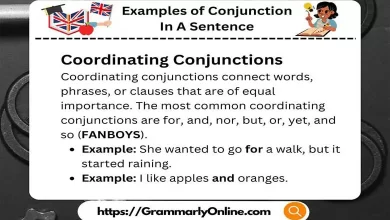10 Examples of Correlative Conjunction
Correlative conjunctions are an essential part of the English language, used to connect words, phrases, or clauses that have equal importance in a sentence. As proficient SEO and high-end copywriters, we understand the intricacies involved in crafting content that not only informs but also engages and ranks well on search engines. In this comprehensive guide, we will delve into the world of correlative conjunctions, providing you with detailed explanations and examples that will enhance your understanding and use of these grammatical tools.
Understanding Correlative Conjunctions
Correlative conjunctions always work in pairs to join elements of equal grammatical rank. They are pivotal in constructing sentences that are both complex and clear. The primary function of correlative conjunctions is to ensure that two elements in a sentence are connected seamlessly, providing balance and symmetry. Some of the most common pairs include:
- Both/And
- Either/Or
- Neither/Nor
- Not only/But Also
- Whether/Or
These pairs play a significant role in sentence construction, allowing writers to express contrasting ideas, combine similar thoughts, or add emphasis to particular elements. Let us explore these pairs with examples to illustrate their application effectively.
10 Examples of Correlative Conjunction
1. Both/And
The correlative conjunction pair both/and is used to add two elements of equal importance together. This pair emphasizes that the two connected items or ideas are equally significant.
Example:
Both the teacher and the student were eager to start the new project.
In this example, both the teacher and the student share equal enthusiasm for the project, highlighting their mutual interest.
2. Either/Or
Either/or is a correlative conjunction pair used to present two options or alternatives. It is typically used when making choices or decisions.
Example:
You can either have the chocolate cake or the vanilla ice cream for dessert.
Here, the choice between chocolate cake and vanilla ice cream is presented, requiring a decision to be made between the two options.
3. Neither/Nor
The pair neither/nor is employed to connect two negative options or statements. It is used to indicate that neither of the two elements is valid.
Example:
Neither the rain nor the wind could dampen our spirits during the festival.
This example highlights that both the rain and the wind failed to affect the participants’ enthusiasm, underscoring a positive attitude despite adverse conditions.
4. Not Only/But Also
The not only/but also pair is used to emphasize the inclusion of additional information or elements that enhance the meaning of the sentence. It is often used to highlight a surprising or noteworthy addition.
Example:
Not only did she excel in her studies, but she also volunteered at the local community center.
This sentence underscores the subject’s academic achievements and their dedication to community service, showcasing a well-rounded character.
5. Whether/Or
Whether/or is a correlative conjunction pair used to present alternatives or possibilities? It is often employed in conditional sentences or when expressing doubt or uncertainty.
Example:
We are unsure whether the meeting will be held online or in person.
In this example, the uncertainty about the mode of the meeting is expressed, with two potential scenarios presented for consideration.
Exploring More Examples of Correlative Conjunctions
To further illustrate the use of correlative conjunctions, let’s explore additional examples that demonstrate their versatility in sentence construction.
6. Both/And in Complex Sentences
Example:
Both the chef and the sous chef collaborated to create a masterpiece of flavors.
In this complex sentence, the correlative conjunction pair both/and is used to emphasize the collaborative effort between the chef and the sous-chef, highlighting their teamwork.
7. Either/Or for Conditional Choices
Example:
The committee will either approve the proposal or request further revisions.
Here, either/or presents two possible outcomes, emphasizing the conditional nature of the committee’s decision-making process.
8. Neither/Nor for Negative Statements
Example:
Neither the manager nor the employees were aware of the upcoming changes to the policy.
This sentence demonstrates the use of neither/nor to connect two negative elements, indicating a lack of awareness among both parties.
9. Not Only/But Also for Emphasis
Example:
The concert was not only entertaining but also educational, offering insights into the history of the music genre.
The use of not only/but also adds emphasis to the dual nature of the concert experience, highlighting its entertainment and educational value.
10. Whether/Or in Hypothetical Scenarios
Example:
We need to decide whether to expand the business internationally or focus on local markets.
In this example, whether/or presents two strategic options, emphasizing the importance of the decision for the business’s future direction.
The Importance of Correlative Conjunctions in Writing
Correlative conjunctions are vital for crafting well-structured and coherent sentences. They provide balance and symmetry, ensuring that ideas are connected logically and meaningfully. By mastering the use of correlative conjunctions, writers can enhance the clarity and impact of their writing, making their content more engaging and effective.
Strategies for Using Correlative Conjunctions Effectively
- Ensure Parallel Structure: When using correlative conjunctions, it is crucial to maintain a parallel structure, ensuring that the elements being connected are grammatically similar. This enhances readability and clarity.
- Avoid Redundancy: Use correlative conjunctions to connect ideas without unnecessary repetition. Be concise and precise in your sentence construction.
- Emphasize Relationships: Utilize correlative conjunctions to highlight relationships between ideas, adding depth and complexity to your writing.
- Practice Variety: While correlative conjunctions are powerful tools, it is important to vary your sentence structures to maintain reader interest and engagement.
Conclusion
Correlative conjunctions are indispensable elements of the English language, enabling writers to construct sentences that are balanced, clear, and impactful. By understanding and applying these conjunction pairs effectively, writers can enhance their content’s readability and engagement, ultimately improving their search engine rankings. As we continue to explore the nuances of grammar and writing, mastering correlative conjunctions will undoubtedly contribute to more compelling and successful content.

